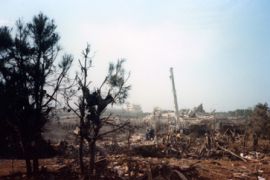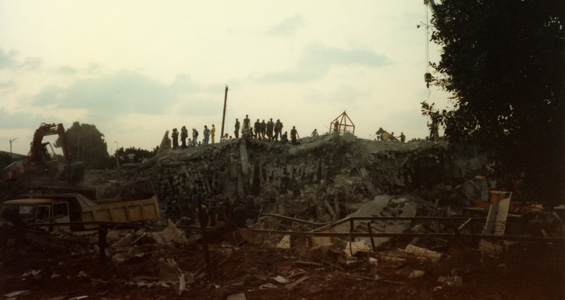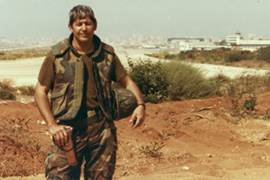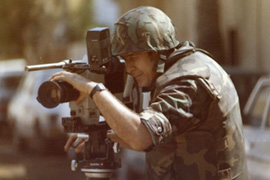Sowing the seeds of US ‘realism’
How the 1983 bombing of a US barracks in Beirut shaped future American foreign policy.

 |
| On October 23, 1983, the US military compound at Beirut International Airport was struck by a truck packed with explosives [Photo courtesy of Glenn Dolphin] |
“The BLT is gone” came a rasping cry, as US Navy senior chief petty officer Joe Ciokon stumbled out of his sleeping quarters and into the choking grey dust that now enveloped the US military compound in Beirut.
It was October 23, 1983 and the Battalion Landing Team (BLT) building – once the focal point of the US Marine Corps headquarters at Beirut International Airport, and home to several hundred American servicemen – was no more, levelled in one deadly second by a suicide lorry bomb.
“We thought we’d been hit by an artillery shell,” recalls Missouri-born Ciokon, then little more than 50-yards away from the BLT in an adjacent building.
“I had been asleep – it was nearly 6:30am, and as it was a Sunday I had decided to have a lie-in – and the next I knew, the wall bulged out and hit me.
 |
| The US military arrived in Lebanon in August 1982 [Photo courtesy of Joe Ciokon] |
“That’s when the bomb went off. I caught a lot of the blast and literally flew across the room, but on my way down to the floor I had the presence of mind to grab my helmet and flak-jacket, which I put on before ducking under a table.”
As debris fell from both the ceiling and the walls, 44-year-old Ciokon – bloodied, bruised but unbowed – scrambled out through the hallway and into the open air where his first thought was to check on the condition of his men.
“My lieutenant came out of the smoke – his nose was bleeding, his ears were bleeding – and he had obviously been concussed pretty bad,” remembers Ciokon, then a US Navy broadcaster whose previous postings had included a five-year spell in Panama and a stint in Vietnam during the 1968 Tet offensive.
“When I got outside, and into the fog, I realised that it was the dust from the BLT, and what we were looking at was the building flattened. We could now see the airport and the [air traffic control] tower. Before that we couldn’t, because it was blocked by BLT. That was a big shock.”
Purveyor of peace
The US military compound had succumbed to a truck packed with explosives – later estimated to be the equivalent of more than 9,500kgs of TNT.
Catching the US position cold, and executed to deadly effect by a then-unknown Iranian-backed Islamic Shia group (now known to be the beginnings of Hezbollah), the truck driver had crashed through the compound’s exposed perimeter before speeding past the sentry guards and detonating in the lobby of the BLT headquarters.
In its then-largest loss of life in a single action since Vietnam, 241 members of the US military were crushed to death.
Arriving as part of a Multi-National Peacekeeping Force (MNF) in August 1982, the US was initially confident of fulfilling its role as a purveyor of peace in a country where hostility between the various Muslim and Christian factions had been raging since 1975.
With Italy, Great Britain and France – the latter of which which would lose 58 servicemen to a truck bomb attack on the same morning as the assault on the US base – making up the rest of the four-nation MNF, a chance to end Lebanon’s bloodshed seemed a not too distant prospect.
But as a staunch ally of Israel, which had not only encouraged its June 1982 invasion, but was now seeking to play broker in a peace deal between the Jewish state and Lebanon’s Christian-led government, the US increasingly found itself at odds with the country’s Muslim population who came to see Washington as little more than military enforcers of US-Israeli policy.
By 1983, and as Syria and its predominantly Muslim allies attempted to wreck the proposed peace accord, and following the suicide attack on the US embassy in April, the US found itself drawn into protecting Lebanon’s now hated regime when it shelled Muslim positions from ships in the Mediterranean – an act now seen as a significant precursor to the suicide bombings of both the US and French barracks.
‘Beacon of hope’
Lance Corporal Craig Renshaw was halfway down the airport runway when dawn broke on October 23. A US Marine Corps machine gunner, Renshaw had just been relieved from guard duty and was settling down to sleep moments before the blast occurred.
 |
| The US withdrew from Lebanon four months after the attack [Photo courtesy of Joe Ciokon] |
“I was just fixing to climb into my sleeping bag when [my comrade] came running inside our bunker to say the BLT had been mortared,” recalls Georgia-born Renshaw.
“I jumped up and ran outside, and you could see the smoke beginning to rise … [soon afterwards] we heard someone saying over the radio, ‘the battalion’s been hit’. ‘How bad?’ came the reply. To which he said, ‘well, it’s a four-storey building, but it’s a one-storey building now’.”
As the 21-year-old machine gunner was ordered back onto line duty at the airport, Ciokon set to work co-ordinating the incoming helicopter rescue teams before resuming his official role as a US Navy broadcaster.
“My team and I were back on [the radio airwaves] within two hours, though television took two or three days to get back on air,” recalls Ciokon, whose first encounter with a fatality from the bombing came when he stumbled across the grim sight of a torso, which he recognised as belonging to a regular gym-buddy.
“I didn’t realise how important [our broadcasting was] until a few days later, when some of the Marines said that when we came back on air, it was like a beacon of hope.”
Abandoning allies
Four months after the attack, Ronald Reagan, the then-US president, withdrew the 1,000-strong American detachment – with the rest of the MNF following suit – forcing the Christian-led Lebanese government to acquiesce to Syrian demands to abandon plans for a formal peace treaty with Israel. With that, Lebanon’s future altered dramatically.
“The Reagan administration, despite some sabre rattling, did abandon Lebanon after the attack on the Marines,” says Dr Sami Baroudi, an associate professor of political science at the Lebanese American University.
“This shifted the internal balance of power [in Lebanon] to the benefit of the attackers and their regional backers. The overall message was that the United States is not invincible and can be coaxed into abandoning its allies when faced with high casualties. This, in my view, encouraged subsequent terrorist attacks on US forces, installations and interests abroad; and might have – just might have – contributed to the 9/11 attacks.”
Stung by its experience in Lebanon, the US fervently adopted a so-called ‘realist’ approach to foreign policy – rejecting grand military schemes and ideological crusades in favour of cold-eyed calculation and co-operation with ‘unpalatable’ regimes – which, according to many political analysts, sowed the seeds of much of the world’s current travails.
“After 1983 … the US [did business] with [Syrian President] Assad, who they had considered an enemy, with Saddam Hussein and others,” says Nadim Shehadi, an associate fellow of the Middle East programme at Chatham House.
“It was a policy which led to the Iran-Iraq war, the creation of the Mujahideen movement [where Osama bin Laden came to prominence] which the US used to oust the Russians from Afghanistan … all of it backfired.”